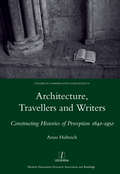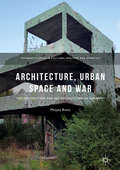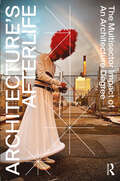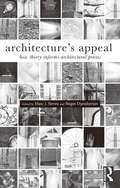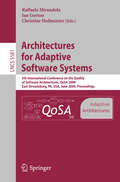- Table View
- List View
Architecture Timed: Designing with Time in Mind (Architectural Design)
by Karen A. FranckThe traditional veneration of architecture for its monumental and enduring qualities seems to be changing. Architects and other designers are moving away from seeking permanence towards a more open, creative use of what time has to offer. This is revealed in new approaches to historic preservation, the proliferation of temporary structures, concerns regarding sustainability, and the employment of time-efficient processes. Architecture Timed explores the role of ideas about time in the design inclinations and choices of contemporary designers of the environment. Contributors consider how the new can be incorporated into the old; how designing for the very short term has significant advantages; how what is temporary can be re-used; and how the design of materials, buildings and landscapes can improve sustainability and enhance experiences of time passing. Many designers have replaced the ideal of ‘timelessness’ and the view of time as a series of singular, static moments with an enriched and more nuanced perspective, treating time as a source of inspiration to be embraced, not a condition to be defended against. Contributors include: Juhani Pallasmaa, Brian McGrath, Federica Goffi, Jill Stoner, Richard Garber and Eric Parry. Designers featured include: Agence Ter, Shigeru Ban, BanG Studio, Diller Scofidio + Renfro, EMF Landscape Architects, Gluck+, GRO Architects, Interboro Partners, Toyo Ito, Kengo Kuma, Enric Miralles, Eric Parry Architects, Carlo Scarpa, Taylor Cullity Lethlean, UNStudio and Peter Zumthor.
Architecture, Travellers and Writers: Constructing Histories of Perception 1640-1950
by Anne HultzschDoes the way in which buildings are looked at, and made sense of, change over the course of time? How can we find out about this? By looking at a selection of travel writings spanning four centuries, Anne Hultzsch suggests that it is language, the description of architecture, which offers answers to such questions. The words authors use to transcribe what they see for the reader to re-imagine offer glimpses at modes of perception specific to one moment, place and person. Hultzsch constructs an intriguing patchwork of local and often fragmentary narratives discussing texts as diverse as the 17th-century diary of John Evelyn, Daniel Defoe's Robinson Crusoe (1719) and an 1855 art guide by Swiss art historian Jacob Burckhardt. Further authors considered include 17th-century collector John Bargrave, 18th-century novelist Tobias Smollett, poet Johann Wolfgang von Goethe, critic John Ruskin as well as the 20th-century architectural historian Nikolaus Pevsner. Anne Hultzsch teaches at the Bartlett School of Architecture, University College London.
Architecture, Travellers and Writers: Constructing Histories of Perception 1640-1950
by Anne HultzschDoes the way in which buildings are looked at, and made sense of, change over the course of time? How can we find out about this? By looking at a selection of travel writings spanning four centuries, Anne Hultzsch suggests that it is language, the description of architecture, which offers answers to such questions. The words authors use to transcribe what they see for the reader to re-imagine offer glimpses at modes of perception specific to one moment, place and person. Hultzsch constructs an intriguing patchwork of local and often fragmentary narratives discussing texts as diverse as the 17th-century diary of John Evelyn, Daniel Defoe's Robinson Crusoe (1719) and an 1855 art guide by Swiss art historian Jacob Burckhardt. Further authors considered include 17th-century collector John Bargrave, 18th-century novelist Tobias Smollett, poet Johann Wolfgang von Goethe, critic John Ruskin as well as the 20th-century architectural historian Nikolaus Pevsner. Anne Hultzsch teaches at the Bartlett School of Architecture, University College London.
Architecture under Construction
by Stanley GreenbergMies van der Rohe once commented, “Only skyscrapers under construction reveal their bold constructive thoughts, and then the impression made by their soaring skeletal frames is overwhelming.” Never has this statement resonated more than in recent years, when architectural design has undergone a radical transformation, and when powerful computers allow architects and engineers to design and construct buildings that were impossible just a few years ago. At the same time, what lies underneath these surfaces is more mysterious than ever before. In Architecture under Construction, photographer Stanley Greenberg explores the anatomy and engineering of some of our most unusual new buildings, helping us to understand our own fascination with what makes buildings stand up, and what makes them fall down. As designs for new constructions are revealed and the public watches closely as architects and engineers challenge each other with provocative new forms and equally audacious ideas, Greenberg captures penetrating images that reveal the complex mystery—and beauty—found in the transitory moments before the skin of a building covers up the structures that hold it together. Framed by a historical and critical essay by Joseph Rosa and including an afterword by the author, the eighty captivating and thought-provoking images collected here—which focus on some of the most high-profile design projects of the past decade, including buildings designed by Norman Foster, Frank Gehry, Steven Holl, Daniel Libeskind, Thom Mayne, and Renzo Piano, among others —are not to be missed by anyone with an eye for the almost invisible mechanisms that continue to define our relationship with the built world.
Architecture under Construction
by Stanley GreenbergMies van der Rohe once commented, “Only skyscrapers under construction reveal their bold constructive thoughts, and then the impression made by their soaring skeletal frames is overwhelming.” Never has this statement resonated more than in recent years, when architectural design has undergone a radical transformation, and when powerful computers allow architects and engineers to design and construct buildings that were impossible just a few years ago. At the same time, what lies underneath these surfaces is more mysterious than ever before. In Architecture under Construction, photographer Stanley Greenberg explores the anatomy and engineering of some of our most unusual new buildings, helping us to understand our own fascination with what makes buildings stand up, and what makes them fall down. As designs for new constructions are revealed and the public watches closely as architects and engineers challenge each other with provocative new forms and equally audacious ideas, Greenberg captures penetrating images that reveal the complex mystery—and beauty—found in the transitory moments before the skin of a building covers up the structures that hold it together. Framed by a historical and critical essay by Joseph Rosa and including an afterword by the author, the eighty captivating and thought-provoking images collected here—which focus on some of the most high-profile design projects of the past decade, including buildings designed by Norman Foster, Frank Gehry, Steven Holl, Daniel Libeskind, Thom Mayne, and Renzo Piano, among others —are not to be missed by anyone with an eye for the almost invisible mechanisms that continue to define our relationship with the built world.
Architecture, Urban Space and War: The Destruction and Reconstruction of Sarajevo (Palgrave Studies in Cultural Heritage and Conflict)
by Mirjana RisticThis book investigates architectural and urban dimensions of the ethnic-nationalist conflict in Sarajevo, the capital of Bosnia and Herzegovina, during and after the siege of 1992–1995. Focusing on the wartime destruction of a portion of the cityscape in central Sarajevo and its post-war reconstruction, re-inscription and memorialization, the book reveals how such spatial transformations become complicit in the struggle for reconfiguration of the city’s territory, boundaries and place identity. Drawing on original research, the study highlights the capacities of architecture and urban space to mediate terror, violence and resistance, and to deal with heritage of the war and act a catalyst for ethnic segregation or reconciliation. Based on a multi-disciplinary methodological approach grounded in architectural and urban theory, the spatial turn in critical social theory and assemblage thinking, as well as techniques of spatial analysis, in particular morphological mapping, the book provides an innovative spatial framework for analyzing the political role of contemporary cities.
Architecture, Urban Space and War: The Destruction and Reconstruction of Sarajevo (Palgrave Studies in Cultural Heritage and Conflict)
by Mirjana RisticThis book investigates architectural and urban dimensions of the ethnic-nationalist conflict in Sarajevo, the capital of Bosnia and Herzegovina, during and after the siege of 1992–1995. Focusing on the wartime destruction of a portion of the cityscape in central Sarajevo and its post-war reconstruction, re-inscription and memorialization, the book reveals how such spatial transformations become complicit in the struggle for reconfiguration of the city’s territory, boundaries and place identity. Drawing on original research, the study highlights the capacities of architecture and urban space to mediate terror, violence and resistance, and to deal with heritage of the war and act a catalyst for ethnic segregation or reconciliation. Based on a multi-disciplinary methodological approach grounded in architectural and urban theory, the spatial turn in critical social theory and assemblage thinking, as well as techniques of spatial analysis, in particular morphological mapping, the book provides an innovative spatial framework for analyzing the political role of contemporary cities.
Architecture Workbook: Design through Motive
by Sir Peter CookOrganised into 9 parts that highlight a wide range of architectural motives, such as ‘Architecture as Theatre’, ‘Stretching the Vocabulary’ and ‘The City of Large and Small’, the workbook provides inspiring key themes for readers to take their cue from when initiating a design. Motives cover a wide-range of work that epitomise the theme. These include historical and Modernist examples, things observed in the street, work by current innovative architects and from Cook’s own rich archive, weaving together a rich and vibrant visual scrapbook of the everyday and the architectural, and past and present.
Architecture Workbook: Design through Motive
by Sir Peter CookOrganised into 9 parts that highlight a wide range of architectural motives, such as ‘Architecture as Theatre’, ‘Stretching the Vocabulary’ and ‘The City of Large and Small’, the workbook provides inspiring key themes for readers to take their cue from when initiating a design. Motives cover a wide-range of work that epitomise the theme. These include historical and Modernist examples, things observed in the street, work by current innovative architects and from Cook’s own rich archive, weaving together a rich and vibrant visual scrapbook of the everyday and the architectural, and past and present.
Architectured Materials in Nature and Engineering: Archimats (Springer Series in Materials Science #282)
by Yuri Estrin Yves Bréchet John Dunlop Peter FratzlThis book deals with a group of architectured materials. These are hybrid materials in which the constituents (even strongly dissimilar ones) are combined in a given topology and geometry to provide otherwise conflicting properties. The hybridization presented in the book occurs at various levels - from the molecular to the macroscopic (say, sub-centimeter) ones. This monograph represents a collection of programmatic chapters, defining archimats and summarizing the results obtained by using the geometry-inspired materials design. The area of architectured or geometry-inspired materials has reached a certain level of maturity and visibility for a comprehensive presentation in book form. It is written by a group of authors who are active researchers working on various aspects of architectured materials. Through its 14 chapters, the book provides definitions and descriptions of the archetypes of architectured materials and addresses the various techniques in which they can be designed, optimized, and manufactured. It covers a broad realm of archimats, from the ones occurring in nature to those that have been engineered, and discusses a range of their possible applications. The book provides inspiring and scientifically profound, yet entertaining, reading for the materials science community and beyond.
Architectures: Modernism and After (New Interventions in Art History)
by Andrew BallantyneArchitectures: Modernism and After surveys the history of the building from the advent of industrialization to the cultural imperatives of the present moment. Brings together international art and architectural historians to consider a range of topics that have influenced the shape, profile, and aesthetics of the built environment. Presents crucial "moments" in the history of the field when the architecture of the past is made to respond to new and changing cultural circumstances. Provides a view of architectural history as a part of a continuing dialogue between aesthetic criteria and social and cultural imperatives. Part of the New Interventions in Art History Series, which is published in conjunction with the Association of Art Historians.
Architecture's Afterlife: The Multisector Impact of an Architecture Degree
by Michela Barosio Dag Boutsen Andrea Čeko Haydée De Loof Johan De Walsche Santiago Gomes Harriet Harriss Roberta Marcaccio Mia Roth-Čerina Carla Sentieri Neal Sashore Federica Vannucchi Hanne Van ReuselAlmost 40% of architecture graduates choose not to practise as architects. Instead, by ‘leaving’ their chosen profession, this surprisingly large but vastly overlooked cohort are making significant contributions to a wide range of other sectors, from politics to videogame design, demonstrating that architectural training can be a pathway to roles, and even leadership opportunities, across a variety of other professions.Architecture’s Afterlife is the first book to examine the sectors into which these graduates migrate, and to identify the transferable skills that are learned, but not always taught, in their degree programmes, and that prove most useful in their new careers.The book – a result of a three-year pan-European study funded by Erasmus+ – provides a roadmap for increasing graduate employment, addressing skills shortages across all sectors and adapting curricula to changing professional landscapes. It is therefore essential reading for all those responsible for curriculum design and delivery in architecture and other disciplines, including deans, professors, postgraduate researchers and policy makers, as well as students and professionals seeking to expand their career prospects.
Architecture's Afterlife: The Multisector Impact of an Architecture Degree
by Michela Barosio Dag Boutsen Andrea Čeko Haydée De Loof Johan De Walsche Santiago Gomes Harriet Harriss Roberta Marcaccio Mia Roth-Čerina Carla Sentieri Neal Sashore Federica Vannucchi Hanne Van ReuselAlmost 40% of architecture graduates choose not to practise as architects. Instead, by ‘leaving’ their chosen profession, this surprisingly large but vastly overlooked cohort are making significant contributions to a wide range of other sectors, from politics to videogame design, demonstrating that architectural training can be a pathway to roles, and even leadership opportunities, across a variety of other professions.Architecture’s Afterlife is the first book to examine the sectors into which these graduates migrate, and to identify the transferable skills that are learned, but not always taught, in their degree programmes, and that prove most useful in their new careers.The book – a result of a three-year pan-European study funded by Erasmus+ – provides a roadmap for increasing graduate employment, addressing skills shortages across all sectors and adapting curricula to changing professional landscapes. It is therefore essential reading for all those responsible for curriculum design and delivery in architecture and other disciplines, including deans, professors, postgraduate researchers and policy makers, as well as students and professionals seeking to expand their career prospects.
Architectures and Synthesizers for Ultra-low Power Fast Frequency-Hopping WSN Radios (Analog Circuits and Signal Processing)
by Emanuele Lopelli Johan van der Tang Arthur H.M. van RoermundWireless sensor networks have the potential to become the third wireless revolution after wireless voice networks in the 80s and wireless data networks in the late 90s. Unfortunately, radio power consumption is still a major bottleneck to the wide adoption of this technology. Different directions have been explored to minimize the radio consumption, but the major drawback of the proposed solutions is a reduced wireless link robustness.The primary goal of Architectures and Synthesizers for Ultra-low Power Fast Frequency-Hopping WSN Radios is to discuss, in detail, existing and new architectural and circuit level solutions for ultra-low power, robust, uni-directional and bi-directional radio links.Architectures and Synthesizers for Ultra-low Power Fast Frequency-Hopping WSN Radios guides the reader through the many system, circuit and technology trade-offs he will be facing in the design of communication systems for wireless sensor networks. Finally, this book, through different examples realized in both advanced CMOS and bipolar technologies opens a new path in the radio design, showing how radio link robustness can be guaranteed by techniques that were previously exclusively used in radio systems for middle or high end applications like Bluetooth and military communications while still minimizing the overall system power consumption.
Architecture's Appeal: How Theory Informs Architectural Praxis
by Marc J. Neveu Negin DjavaherianThis collection of previously unpublished essays from a diverse range of well-known scholars and architects builds on the architectural tradition of phenomenological hermeneutics as developed by Dalibor Veseley and Joseph Rykwert and carried on by David Leatherbarrow, Peter Carl and Alberto Pérez-Gómez. Taking an interdisciplinary approach and drawing on ideas from beyond the architectural canon, contributors including Kenneth Frampton, David Leatherbarrow, Juhani Pallasmaa, Karsten Harries, Steven Holl, Indra Kagis McEwen, Paul Emmons, and Louise Pelletier offer new insights and perspectives on questions such as the following: Given the recent fascination with all things digital and novel, what is the role of history and theory in contemporary architectural praxis? Is authentic meaning possible in a technological environment that is so global and interconnected? What is the nature and role of the architect in our shared modern world? How can these questions inform a new model of architectural praxis? Architecture's Appeal is a thought-provoking book which will inspire further scholarly inquiry and act as a basis for discussion in the wider field as well as graduate seminars in architectural theory and history.
Architecture's Appeal: How Theory Informs Architectural Praxis
by Marc J. Neveu Negin DjavaherianThis collection of previously unpublished essays from a diverse range of well-known scholars and architects builds on the architectural tradition of phenomenological hermeneutics as developed by Dalibor Veseley and Joseph Rykwert and carried on by David Leatherbarrow, Peter Carl and Alberto Pérez-Gómez. Taking an interdisciplinary approach and drawing on ideas from beyond the architectural canon, contributors including Kenneth Frampton, David Leatherbarrow, Juhani Pallasmaa, Karsten Harries, Steven Holl, Indra Kagis McEwen, Paul Emmons, and Louise Pelletier offer new insights and perspectives on questions such as the following: Given the recent fascination with all things digital and novel, what is the role of history and theory in contemporary architectural praxis? Is authentic meaning possible in a technological environment that is so global and interconnected? What is the nature and role of the architect in our shared modern world? How can these questions inform a new model of architectural praxis? Architecture's Appeal is a thought-provoking book which will inspire further scholarly inquiry and act as a basis for discussion in the wider field as well as graduate seminars in architectural theory and history.
Architecture’s Disability Problem (Routledge Research in Architecture)
by Wanda Katja LiebermannArchitecture’s Disability Problem explores the intersection of architecture and disability in the United States from the perspective of professional practice. This book uncovers why, despite the profound effect of the Americans with Disabilities Act on the architectural profession, there has been so little interest in design for disability in mainstream architecture. To counter this, the book investigates alternative approaches to designing with disability, through three case studies. These showcase both buildings and how design processes driven by disabled people shape design and professional roles.Combining historical research, formal and discourse analysis, and interviews with people who design, construct, use buildings, and advocate for access, the book develops a social understanding of how the buildings work at functional, affective, and symbolic levels. Architecture’s Disability Problem is aimed at three primary readers: practicing architects, architectural scholars, and members of disability scholar-activist communities. Grounded in detailed design studies, the author hopes to unearth the social meaning-making of architecture related to disability. Ultimately, the book makes an argument for a focus on disability in its own right—as well as on the body—in place of the dominance of formal, object-oriented approaches.This book presents and argues for a fundamental shift in the way architectural education, policy, and practice views and engages with disability. It will be key reading for students, researchers, practitioners and policy-makers.
Architecture’s Disability Problem (Routledge Research in Architecture)
by Wanda Katja LiebermannArchitecture’s Disability Problem explores the intersection of architecture and disability in the United States from the perspective of professional practice. This book uncovers why, despite the profound effect of the Americans with Disabilities Act on the architectural profession, there has been so little interest in design for disability in mainstream architecture. To counter this, the book investigates alternative approaches to designing with disability, through three case studies. These showcase both buildings and how design processes driven by disabled people shape design and professional roles.Combining historical research, formal and discourse analysis, and interviews with people who design, construct, use buildings, and advocate for access, the book develops a social understanding of how the buildings work at functional, affective, and symbolic levels. Architecture’s Disability Problem is aimed at three primary readers: practicing architects, architectural scholars, and members of disability scholar-activist communities. Grounded in detailed design studies, the author hopes to unearth the social meaning-making of architecture related to disability. Ultimately, the book makes an argument for a focus on disability in its own right—as well as on the body—in place of the dominance of formal, object-oriented approaches.This book presents and argues for a fundamental shift in the way architectural education, policy, and practice views and engages with disability. It will be key reading for students, researchers, practitioners and policy-makers.
Architectures for Adaptive Software Systems: 5th International Conference on the Quality of Software Architectures, QoSA 2009, East Stroudsburg, PA, USA, June 24-26, 2009 Proceedings (Lecture Notes in Computer Science #5581)
by Raffaela Mirandola Ian Gorton Christine HofmeisterMuch of a software architect’s life is spent designing software systems to meet a set of quality requirements. General software quality attributes include scalability, security, performance or reliability. Quality attribute requirements are part of an application’s non-functional requirements, which capture the many facets of how the functional - quirements of an application are achieved. Understanding, modeling and continually evaluating quality attributes throughout a project lifecycle are all complex engineering tasks whichcontinuetochallengethe softwareengineeringscienti ccommunity. While we search for improved approaches, methods, formalisms and tools that are usable in practice and can scale to large systems, the complexity of the applications that the so- ware industry is challenged to build is ever increasing. Thus, as a research community, there is little opportunity for us to rest on our laurels, as our innovations that address new aspects of system complexity must be deployed and validated. To this end the 5th International Conference on the Quality of Software Archit- tures (QoSA) 2009 focused on architectures for adaptive software systems. Modern software systems must often recon guretheir structure and behavior to respond to c- tinuous changes in requirements and in their execution environment. In these settings, quality models are helpful at an architectural level to guide systematic model-driven software development strategies by evaluating the impact of competing architectural choices.
Architectures for Baseband Signal Processing
by Frank KienleThis book addresses challenges faced by both the algorithm designer and the chip designer, who need to deal with the ongoing increase of algorithmic complexity and required data throughput for today’s mobile applications. The focus is on implementation aspects and implementation constraints of individual components that are needed in transceivers for current standards, such as UMTS, LTE, WiMAX and DVB-S2. The application domain is the so called outer receiver, which comprises the channel coding, interleaving stages, modulator, and multiple antenna transmission. Throughout the book, the focus is on advanced algorithms that are actually in use in modern communications systems. Their basic principles are always derived with a focus on the resulting communications and implementation performance. As a result, this book serves as a valuable reference for two, typically disparate audiences in communication systems and hardware design.
Architectures for Computer Vision: From Algorithm to Chip with Verilog
by Hong JeongThis book provides comprehensive coverage of 3D vision systems, from vision models and state-of-the-art algorithms to their hardware architectures for implementation on DSPs, FPGA and ASIC chips, and GPUs. It aims to fill the gaps between computer vision algorithms and real-time digital circuit implementations, especially with Verilog HDL design. The organization of this book is vision and hardware module directed, based on Verilog vision modules, 3D vision modules, parallel vision architectures, and Verilog designs for the stereo matching system with various parallel architectures. Provides Verilog vision simulators, tailored to the design and testing of general vision chips Bridges the differences between C/C++ and HDL to encompass both software realization and chip implementation; includes numerous examples that realize vision algorithms and general vision processing in HDL Unique in providing an organized and complete overview of how a real-time 3D vision system-on-chip can be designed Focuses on the digital VLSI aspects and implementation of digital signal processing tasks on hardware platforms such as ASICs and FPGAs for 3D vision systems, which have not been comprehensively covered in one single book Provides a timely view of the pervasive use of vision systems and the challenges of fusing information from different vision modules Accompanying website includes software and HDL code packages to enhance further learning and develop advanced systems A solution set and lecture slides are provided on the book's companion website The book is aimed at graduate students and researchers in computer vision and embedded systems, as well as chip and FPGA designers. Senior undergraduate students specializing in VLSI design or computer vision will also find the book to be helpful in understanding advanced applications.
Architectures for Computer Vision: From Algorithm to Chip with Verilog
by Hong JeongThis book provides comprehensive coverage of 3D vision systems, from vision models and state-of-the-art algorithms to their hardware architectures for implementation on DSPs, FPGA and ASIC chips, and GPUs. It aims to fill the gaps between computer vision algorithms and real-time digital circuit implementations, especially with Verilog HDL design. The organization of this book is vision and hardware module directed, based on Verilog vision modules, 3D vision modules, parallel vision architectures, and Verilog designs for the stereo matching system with various parallel architectures. Provides Verilog vision simulators, tailored to the design and testing of general vision chips Bridges the differences between C/C++ and HDL to encompass both software realization and chip implementation; includes numerous examples that realize vision algorithms and general vision processing in HDL Unique in providing an organized and complete overview of how a real-time 3D vision system-on-chip can be designed Focuses on the digital VLSI aspects and implementation of digital signal processing tasks on hardware platforms such as ASICs and FPGAs for 3D vision systems, which have not been comprehensively covered in one single book Provides a timely view of the pervasive use of vision systems and the challenges of fusing information from different vision modules Accompanying website includes software and HDL code packages to enhance further learning and develop advanced systems A solution set and lecture slides are provided on the book's companion website The book is aimed at graduate students and researchers in computer vision and embedded systems, as well as chip and FPGA designers. Senior undergraduate students specializing in VLSI design or computer vision will also find the book to be helpful in understanding advanced applications.
Architectures for Enterprise Integration (IFIP Advances in Information and Communication Technology)
by Peter Bernus Laszlo Nemes Theodore J. WilliamsArchitectures for Enterprise Integration describes the latest methods to guide enterprises and consultants, managers and technical personnel through a complete life-cycle of enterprise development. This book is based on the findings of the IFIP/IFAC Task Force and presents the state-of-the-art in enterprise architecture. This book is essential reading for all practising engineers and researchers in manufacturing and engineering management with special interest for those involved in CIM and Enterprise Modelling and Integration.
Architectures for Intelligence: The 22nd Carnegie Mellon Symposium on Cognition (Carnegie Mellon Symposia on Cognition Series)
by Kurt Van LehnThis unique volume focuses on computing systems that exhibit intelligent behavior. As such, it discusses research aimed at building a computer that has the same cognitive architecture as the mind -- permitting evaluations of it as a model of the mind -- and allowing for comparisons between computer performance and experimental data on human performance. It also examines architectures that permit large, complex computations to be performed -- and questions whether the computer so structured can handle these difficult tasks intelligently.
Architectures for Intelligence: The 22nd Carnegie Mellon Symposium on Cognition (Carnegie Mellon Symposia on Cognition Series)
by Kurt VanLehnThis unique volume focuses on computing systems that exhibit intelligent behavior. As such, it discusses research aimed at building a computer that has the same cognitive architecture as the mind -- permitting evaluations of it as a model of the mind -- and allowing for comparisons between computer performance and experimental data on human performance. It also examines architectures that permit large, complex computations to be performed -- and questions whether the computer so structured can handle these difficult tasks intelligently.

